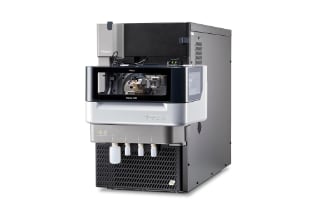Targeted Mass Spectrometry Imaging (MSI)
Unlock previously inaccessible molecular spatial information
Mass spectrometry imaging (MSI) has been successfully used to localize a sample’s molecular composition in-situ. However, due to sample complexity, the presence of salt, and other interferences, the detection of low-level analytes can be especially challenging.
DESI XS MSI is typically applied for the mapping of small molecules directly from tissue sections and, combined with time-of-flight (ToF)-based mass spectrometers, is ideally suited to untargeted discovery analysis. Tandem quadrupole (TQ) mass spectrometers, on the other hand, are renowned for their sensitivity, speed, and quantitative robustness for targeted applications using Multi Reaction Monitoring (MRM) modes of acquisition, and are widely adopted for drug quantitation. With a combination of the two technologies, a remarkable and unique technique emerges to perform sensitive, fast, and quantitative MSI directly on surfaces.
The Future of Breast Cancer Screening?
At Waters, we’re constantly innovating our mass spectrometry systems to improve human health, like this groundbreaking advance in breast cancer detection.

Overview
- Simply and quickly access lower limits of detection in molecular visualization directly from surfaces
- Reduce the data size and interpretation burden of complex, full scan MS imaging data sets
- Visualize and quantify known biomarkers, APIs, and metabolites at therapeutic and low biological concentrations
- Combine sensitivity with high throughput analysis to handle large imaging studies efficiently
- Obtain comprehensive and detailed spatial information with limited sample preparation
- Add MSI analysis into a multi-modal imaging workflow with ease
- Achieve improved environmental sustainability and lower laboratory operational costs with an MSI system that uses 50% less electricity and gas and produces 50% less heat than most other QQQ systems
Recommended Use: To visualize and quantify known compounds, biomarkers, APIs, and metabolites at therapeutic and low concentrations at speed.
Features Header
Visualize the location of previously inaccessible components
MS imaging offers the ability to directly detect, visualize, and quantify cellular and molecular events in situ, opening up huge possibilities to advance the understanding of biological systems and materials science. Direct MS analysis on a tissue or material’s surface prevents compound-specific sample preparation, which can challenge the detection of certain molecules. Waters targeted MS imaging system is at least five times more sensitive than discovery HRMS MS Imaging systems meaning that compounds can be accessed at lower levels than previously possible or even visualized for the first time. High sensitivity imaging mitigates the need for follow up analysis like laser capture microdissection LC-MS – saving time and cost of analysis. Gain confidence by bringing your molecules out of the weeds with the power of unparalleled sensitivity
See the whole picture, not just a snapshot
The rapid speed of targeted MSI analysis on the Xevo TQ Absolute means it is possible to collect larger cohorts of images in a timely manner. Data in pharma workflows can now be collected on whole studies with biological replicates, increasing statistical confidence in results over a smaller study snapshot.
Leverage the power of selectivity
Multiple reaction monitoring (MRM), a highly sensitive and selective method of targeted mass spectrometry (MS), measures and quantifies only the molecules specified by their precursor-to-fragment ion transitions. MRM-based imaging data acquired on a DESI XS enabled TQ mass spectrometer increases your throughput while keeping the amount of data required to the minimum, lowering your costs on data analysis and storage.
MS imaging quantification
A visual representation of where a compound is situated on a segment of tissue can provide a powerful insight into the relevance of a biomarker or the toxicity of a drug or metabolite. The next logical question is how much is there relative to a normal or safe amount.
Tandem quadrupoles are an industry standard solution for accurate and sensitive quantification via LC-MS methods. The exceptional sensitivity, linearity, and dynamic range of the Xevo TQ Absolute combined with DESI XS alongside the MSI Quantify MicroApp can now aid quantification workflows in mass spectrometry-based imaging.
